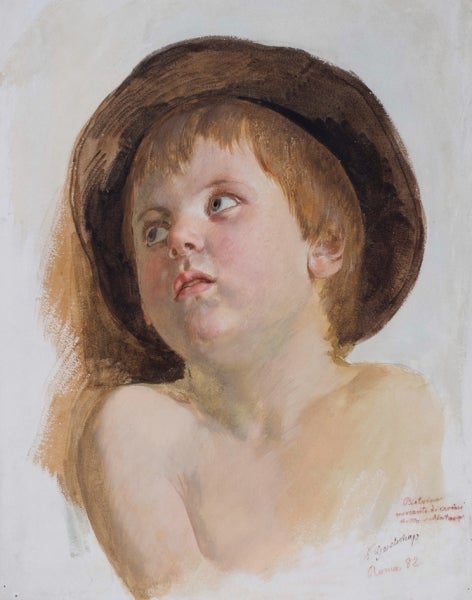
Young Child, Rome 1882
Watercolour Born in may 3rd 1835 in Wesel - Died in May 31th 1898 in Roma Friedrich Geselschap was a son one of the oldest merchants' families of Wesel. He was born in May 3rd 1835. After the early death of his parents he lived with his relatives in Silesia. He never lost contact to his home. After finishing his school education he performed the same job as his 21years elder brother Eduard Geselschap and studied painting in Dresden, Duesseldorf, Berlin and different cities in Italy. In 1871 he retired in Berlin and became one of the famous history painters of the late 19th century. At that time this kind of art promoted such a progress for the national identity of the German Empire. This kind of art set up slowly after the wars between 1813and 1815 at the time of the Romantic. Before this time there had not been any type of what one might call national pride. Only the same language kept them together. The Romantic searched for one national pride and began to evolve. They chose the old methods of the middle ages reaching a German unity and brought German culture to its peek. They built literary monuments for Duerer and Gutenberg, they restored monuments and at least they wanted to upgrade the Cathedral of Cologne. Furthermore fairy tales and collections of folk songs were developed. There were also actual painters who got engaged in historical paintings with their pictures showing themes describing the political-historical culture of that time. A historical painting expressed a common memory of culture passed and it offered an identification with National Importance, with heroes. Whereas painters living around 1800 still preferred antique ideas artists of the first decades of the 19th century painted historical themes and literature events of their national history creating monumental fresco paintings for the decoration of residences, castles, fortresses, town halls, halls, private residences, churches and museums. Also in the art academies mainly in Berlin, Duesseldorf and Munich a national feeling and a national consciousness developed. Friedrich Geselschap got official orders which brought manifold prestige to his reputation. The illumination of the Hall of Fame in the so called Zeughaus of Berlin, mosaic in the Kaiser-Wilhelm- Memorial Church and a painting for the Beethoven-house in Bonn became some of his most famous activities. He donated a glass window showing the Sermon on the Mount to the Willibrordi Cathedral in Wesel which regretfully was disturbed in World War II. Friedrich Geselschap died during a trip through Italy in Rome on 13sr May 1898.
42 x 32 cm
Signed, dated and inscribed Roma
Item #4747
Sold

